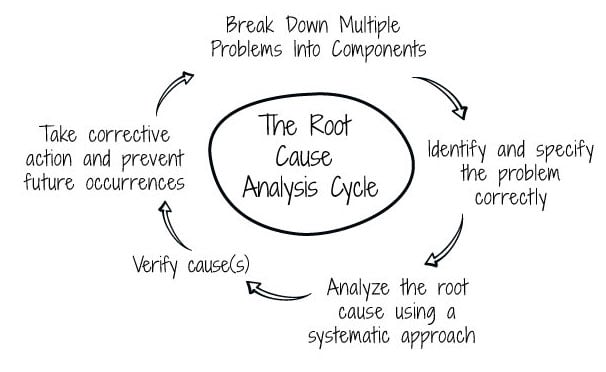We often do ‘root cause analysis’ and conclude that a specific cause is present, for which cause we promptly proceed to solutions, to only find in due course that the same problem recurs. While in such cases we may seem to be following proper process, we are in actual fact not doing so, else the problem would not recur. As people who have a natural tendency to jump to conclusion and to fix urgently since this solves the issue. For tougher problems, to avoid this pitfall, we can exploit the human inclination of quick conclusion and solution, and add a little patience and use more time.
Try the following sequence (if you are familiar with a KEPNERandFOURIE CauseWise at all levels, this adjusted approach will be familiar to you):
- Do a Proper Problem Statement with Object and Fault.
- List 2 or 3 critically unique features of the problem.
- Now accommodate your urge and list possible causes.
- Test the possible causes using the “Thinking On Your Feet” Approach, and eliminate those possible causes that is clearly not the cause. This results in a short-list of possible causes.

“What we succeeded in doing is forcing ourselves to better understand the problem better and not to jump to a solution, secondly we know largely what the cause is not.”
- > Proceed to build a proper CauseWise Problem Specification based on the prior learnings, and the test the remaining causes critically.
- > For all causes surviving the test on paper, force yourself to devise a plan to critically verify whether the cause tested on paper is actually the direct of the of problem, for each cause, ask yourself:
“What is the easiest / cheapest / viable / cost effective manner in which to verify whether this is actually the direct cause of the problem.”
- > Only when such verification indicates that we have concluded correctly that a specific technical aspect is the direct cause of a incident, can we ask “Why?” this technical event occurred, leading us to the systemic root cause thereof.
Following the foregoing guide may take a little more time, but the probability of you finding root cause first time is enhanced substantially. However, it will only be true if you ensure that you have the appropriate people with the right knowledge involved in the process. Without the right people and information present, all root cause analysis activity remains mere speculation.
Dr. Chuck Kepner on occasion remarked that “if you can not solve a problem, the right people are not present in the session”.
If the root cause of a problem has been found, again put the brakes on and do a basic review of all the potential consequences of implementing the intended solution. Check Your Thinking or RiskWise are ideal tools for this purpose.




